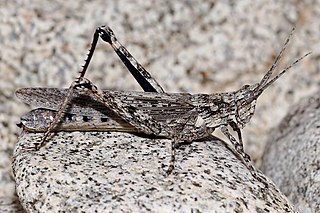
Acrididae, commonly called short-horned grasshoppers, are the predominant family of grasshoppers, comprising some 10,000 of the 11,000 species of the entire suborder Caelifera. The Acrididae are best known because all locusts are of the Acrididae. The subfamily Oedipodinae is sometimes classified as a distinct family Oedipodidae in the superfamily Acridoidea. Acrididae grasshoppers are characterized by relatively short and stout antennae, and tympana on the side of the first abdominal segment.
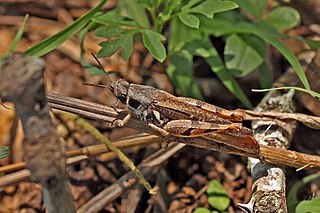
The subfamily Catantopinae is a group of insects classified under family Acrididae. Genera such as Macrotona may sometimes called "spur-throated grasshoppers", but that name is also used for grasshoppers from other subfamilies, including the genus Melanoplus from the Melanoplinae.

The grasshopper subfamily Acridinae, sometimes called silent slant-faced grasshoppers, belong of the large family Acrididae in the Orthoptera: Caelifera.

The Calliptaminae are a subfamily of grasshoppers containing species found in Africa, Europe and Asia; some are economically important. It was originally erected as a tribe by G.G. Jacobson in 1905 as the "Calliptamini", later uprated by Dirsh in 1956.

Lentula is a small genus of grasshoppers native to southern Africa. It is the type genus of the family Lentulidae.

Schistocerca is a genus of grasshoppers, commonly called bird grasshoppers, many of which swarm as locusts. The best known species is probably the desert locust and trans-Atlantic flight may explain the biogeography of some locust species.
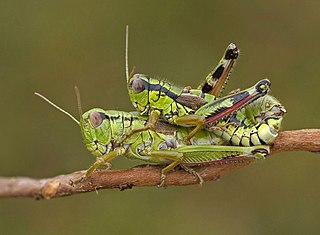
Acridoidea is the largest superfamily of grasshoppers in the order Orthoptera with species found on every continent except Antarctica.

Pamphagidae is a family of grasshoppers belonging to the superfamily Acridoidea. The species in this family can be found in Africa, Europe and Asia.

Catantops is a genus of grasshoppers in the tribe Catantopini and is typical of the subfamily Catantopinae. Species can be found in Africa, including Madagascar and subcontinental India.
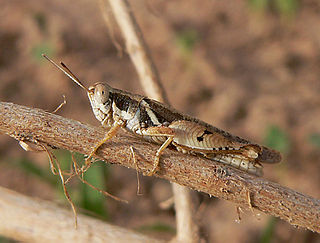
Cryptocatantops is a genus of grasshoppers in the subfamily Catantopinae, a group of insects primarily found in Africa. As numerous other genera, it is not yet assigned to a particular tribe.
Cryptocatantops debilis is a species of grasshoppers in the subfamily Catantopinae, a group of insects commonly called spur-throated grasshoppers. The type specimen was a female found in Omaruru, Namibia.
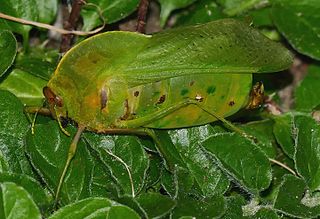
The Pneumoridae are a family of nocturnal short-horned grasshoppers in the order Orthoptera, commonly known as the bladder grasshoppers and the sole representative of the superfamily Pneumoroidea. Their centre of diversity is in southern Africa, but one species occurs as far north as South Sudan. Most adult males acquire an inflated abdomen, a specialization for amplified sound production, which is likely its primary function. Most genera display striking sexual dimorphism, and several species exhibit a dual male phenotype.

The Lentulidae are a family of flightless grasshoppers found in sub-Saharan Africa.
The Lithidiidae are a family of grasshoppers, in the Orthoptera: suborder Caelifera. Species in this family can be found in Africa.

The Hemiacridinae are a subfamily of Acrididae in the Orthoptera: Caelifera. Species can be found in Africa and Asia.

The Orthacridinae are a sub-family of grasshoppers in the family Pyrgomorphidae. Species are found in: Central America, Africa, Asia, Australia and certain Pacific Islands. The type genus is Orthacris and the taxon proposed by Bolívar in 1905.

Stenocatantops is a genus of grasshoppers in the family Acrididae and subfamily Catantopinae. The recorded distribution of species includes: India, China, Indo-China and Malesia through to Australia.
The Euryphyminae are a subfamily of grasshoppers in the family Acrididae, based on the type genus Euryphymus and may be called "agile grasshoppers"; it was erected by Vitaly Michailovitsh Dirsh in 1956. Species have been recorded from parts of sub-Saharan Africa including Madagascar.
Cryptocatantops uvarovi is a species of grasshopper in the Cryptocatantops genus found in Somalia.













